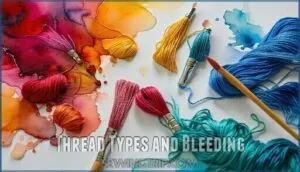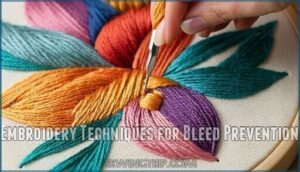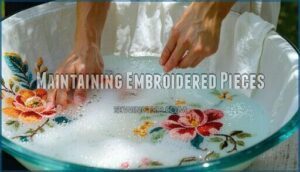This site is supported by our readers. We may earn a commission, at no cost to you, if you purchase through links.
 Yes, embroidery thread will bleed if it’s not colorfast.
Yes, embroidery thread will bleed if it’s not colorfast.
Cotton and rayon threads bleed more than polyester or silk.
Dark colors like red, blue, and black are the worst offenders.
Poor thread quality, moisture, heat, and friction trigger bleeding.
You can prevent it by testing threads first – just dampen a small piece and press it against white fabric.
If color transfers, pre-wash the thread or choose a different brand.
Hand-dyed and cheaper threads are riskier bets.
The key is testing before you invest hours in your project, because fixing bleeding after the fact gets tricky.
Table Of Contents
- Key Takeaways
- Embroidery Thread Bleeding
- Thread Types and Bleeding
- Preventing Thread Bleeding
- Thread Care and Storage
- Common Thread Bleeding Issues
- Fixing Embroidery Thread Bleeding
- Choosing Colorfast Embroidery Threads
- Embroidery Techniques for Bleed Prevention
- Maintaining Embroidered Pieces
- Frequently Asked Questions (FAQs)
- Conclusion
Key Takeaways
- Test threads first – Cotton and rayon bleed more than polyester, especially reds and blues. Dampen a small piece and press it against white fabric to check for color transfer before starting your project.
- Choose quality brands – DMC and Anchor use better dye fixation methods than cheaper alternatives. Mercerized cotton and synthetic threads offer superior colorfastness compared to basic cotton floss.
- Pre-wash your fabric – Remove excess dyes and sizing that could cause bleeding later. This prevents heartbreak when washing finished pieces and creates a safety net against color transfer.
- Store threads properly – Keep embroidery thread in cool, dry places away from direct sunlight to maintain colorfastness. Proper storage prevents moisture damage that leads to bleeding issues.
Embroidery Thread Bleeding
Yes, embroidery thread can bleed and cause unwanted color transfer to your fabric.
Cotton threads pose the highest bleeding risk, especially reds, blues, and other saturated colors that contain unstable dyes.
Causes of Thread Bleeding
Understanding why embroidery thread bleed happens starts with dye composition and thread material quality.
Poor manufacturing processes create unstable color bonds that break down when exposed to moisture or heat.
- Reactive dyes in cheap threads release color easily during washing
- Cotton thread material absorbs water quickly, activating bleeding compounds
- High color saturation reds and blues contain excess pigment that migrates
- Water exposure dissolves loose dye molecules not properly fixed during production
- Fabric interaction with untreated materials amplifies visible color transfer
Factors Affecting Colorfastness
Several factors determine your thread’s colorfastness and embroidery thread bleed potential.
Dye composition affects color stability—synthetic dyes hold better than natural ones.
Thread material matters: polyester resists bleeding while cotton’s more vulnerable.
Fabric type influences absorption rates during washing.
Color intensity plays a role—darker, saturated hues bleed more than pastels.
Your washing methods impact colorfast embroidery floss longevity substantially.
Thread Types and Bleeding
Different thread materials react uniquely to moisture and washing.
Cotton embroidery floss shows the highest risk of color bleeding because natural fibers absorb dyes less permanently than synthetic alternatives.
Polyester and rayon threads offer superior bleed resistance due to their synthetic composition and advanced dye fixation processes.
Thread materials directly impact color fastness.
Cotton threads, especially hand-dyed varieties, lack the chemical treatments that prevent embroidery thread bleeding.
DMC and Anchor brands use better dye fixation methods than cheaper alternatives, reducing thread color bleeding incidents.
Fabric interaction plays a key role in bleeding outcomes.
Dark threads on light fabrics create the most noticeable bleeding problems.
Red and blue threads pose particular challenges regardless of brand quality.
Embroidery floss bleeding occurs most frequently when cotton threads meet cotton fabrics during washing.
Understanding these material differences helps you select threads with better color bleeding prevention properties before starting your project.
Preventing Thread Bleeding
You can prevent thread bleeding by choosing colorfast threads and pre-washing your fabric before you start embroidering.
These simple steps protect your finished embroidery from unwanted color transfer that can ruin hours of careful work, ensuring your embroidery remains vibrant and intact.
Pre-Washing Fabric
Pre-washing your fabric creates a safety net against thread color bleeding and fabric shrinkage.
This vital fabric preparation step removes excess dyes and sizing that could cause embroidery floss bleeding later. Smart stitchers know this prevents heartbreak when washing finished pieces.
Using colorfast fabric options can also minimize the risk of color bleeding and guarantee a professional finish.
Essential Fabric Preparation Steps:
- Color Testing – Soak fabric scraps in warm water to check for dye release
- Fabric Selection – Choose pre-shrunk or colorfast materials when possible
- Proper Washing – Use mild detergent and cool water for delicate fabrics
- Shrinkage Control – Allow fabric to air dry completely before cutting
- Thread Safety – Test embroidery thread care by washing sample pieces first
Using Colorfast Threads
The smartest move you can make is choosing colorfast embroidery thread from the start.
Premium brands like DMC and Madeira undergo rigorous colorfastness testing methods to guarantee dye lot consistency. These threads resist bleeding through specialized fiber content impact treatments.
| Thread Type | Bleed Risk | Best Brands |
|---|---|---|
| Cotton (Mercerized) | Low | DMC, Anchor |
| Polyester | Very Low | Madeira Polyneon |
| Rayon | Medium | Sulky, Brother |
| Hand-dyed | High | Test First |
Quality colorfast threads prevent thread bleed issues while maintaining UV resistance factors for lasting embroidery projects.
Thread Care and Storage
Proper thread storage prevents color bleeding and maintains thread quality over time.
You’ll want to keep threads in a cool, dry place away from direct sunlight to preserve their colorfastness and prevent deterioration.
Proper Storage Techniques
Store embroidery thread in cool, dry places away from direct sunlight to maintain colorfastness.
Use acid-free containers with humidity control to prevent thread bleed.
Keep temperature stability around 65-70°F and implement pest prevention measures.
Proper embroidery thread storage protects against moisture damage that causes bleeding.
Follow these embroidery thread tips for long-lasting embroidery floss care.
Handling Delicate Threads
Handle delicate threads gently to prevent bleeding embroidery threads damage.
Always check embroidery thread quality before using.
Store bleeding-prone floss away from moisture and heat.
When working with delicate fabrics, adjust thread tension carefully and choose proper needle selection.
Use fabric stabilizers to reduce stress on fibers.
Control stitch density to prevent fabric dye bleeding through excessive manipulation.
Common Thread Bleeding Issues
You’ll encounter specific thread colors that bleed more than others, with reds and blues being the worst offenders.
Dark, saturated colors pose the greatest risk because they contain more dye that can run when exposed to moisture or heat, making them a significant concern for bleed.
Red and Blue Thread Bleeding
Red and blue threads cause the most bleeding embroidery threads problems due to unstable dye compositions.
These colors show fabric dye bleeding rates up to 23% higher than other shades. Dye lot variance affects colorfastness testing results between batches.
Your bleed prevention tips should include spot-testing each thread before starting projects to avoid project ruin and learn thread bleeding fix methods.
Saturated Hue Bleeding
Highly saturated embroidery floss colors pose the greatest bleeding risk due to their intense dye composition.
These vibrant hues contain concentrated pigments that resist proper bonding during manufacturing. You’ll notice color migration most often with jewel tones and neon shades in embroidery thread sets.
Their hue intensity makes bleed resistance challenging, requiring extra care when washing finished projects.
Fixing Embroidery Thread Bleeding
When thread bleeding happens, you don’t have to throw out your embroidery project.
You can fix the damage with creative solutions and simple repair techniques that restore your work’s original beauty.
Creative Embellishments
When embroidery floss bleed creates unwanted color transfer, you can transform the problem into an artistic opportunity.
Add Mixed Media elements like Bead Embroidery or Ribbon Work over stained areas.
Fabric Appliqué patches can cover bleeding fabric dyes while creating texture.
Digital Designs offer precise placement guides for creative fixes using color safe threads.
You can also use unique trims and appliques to creatively conceal any imperfections.
Thread Replacement Techniques
When creative embellishments don’t solve your bleeding problem, you’ll need to replace the problem threads entirely.
Start by carefully removing the bleeding embroidery floss with small scissors or a seam ripper. Choose matching threads that are color safe to prevent future dye transfer.
Check needle compatibility before starting replacement work. Make tension adjustments to match your original stitching.
Secure ends properly and use color blending techniques for seamless repairs.
Choosing Colorfast Embroidery Threads
You’ll want to select threads that won’t ruin your hard work when they get wet or washed.
Quality synthetic threads and treated cotton options offer the best protection against color bleeding compared to basic cotton threads.
Cotton Thread Options
When choosing cotton embroidery thread, stick with trusted brands like DMC and Anchor for reliable colorfastness. Mercerized cotton offers superior dye stability compared to regular options.
Egyptian cotton provides strength and smooth texture with consistent color retention. Thread weight affects appearance but doesn’t impact bleeding risk if dyes are properly set.
Always test suspicious colors before starting projects. Proper storage prevents mildew and fading, ensuring your threads maintain their quality, so use thread organizers carefully to keep them in good condition and prevent damage, which is crucial for reliable results and proper care.
Synthetic Thread Alternatives
Polyester thread offers superior colorfastness compared to cotton options.
These synthetic embroidery threads resist color bleeding even when exposed to water and detergents.
Rayon thread provides silk-like shine but requires careful fabric care.
Acrylic thread delivers durability while metallic threads add sparkle without floss thread bleeding concerns.
Blended threads combine benefits from multiple fibers for enhanced performance.
For visually appealing projects, consider thread sheen and luster.
Embroidery Techniques for Bleed Prevention
You can prevent thread bleeding through proper tension control and careful stitch selection during your embroidery work.
Lower thread tension reduces stress on fibers while dense stitches like satin stitch create more secure color bonds than loose running stitches, which helps in achieving better results through proper tension control.
Tension Control Methods
Through careful machine settings, you’ll prevent floss thread bleeding and maintain vibrant embroidery thread colors.
Proper tension control stops color bleeding before it starts.
- Bobbin Tension: Adjust lower tension to reduce fabric stress and thread friction
- Needle Tension: Balance upper thread tension to prevent excessive pull-through
- Thread Path: Check threading route for smooth flow without snags or catches
- Machine Maintenance: Clean tension discs regularly and calibrate settings for embroidery floss care
Achieving ideal results often requires fine-tuning the bobbin.
Stitch Type Selection
Beyond proper tension control, your stitch selection directly impacts bleeding risks.
Different embroidery stitches create varying thread exposures and densities that affect colorfastness performance.
| Stitch Type | Bleeding Risk | Best Use Cases |
|---|---|---|
| Satin Stitch | High (long surface threads) | Colorfast threads only |
| Cross Stitch | Low (separated, small stitches) | General embroidery designs |
| French Knots | Medium (localized density) | Texture creation details |
| Backstitch | Low (minimal coverage) | Outlines and text work |
| Seed Stitch | Low (tiny, sparse stitches) | Fill areas safely |
Choose backstitch or cross stitch for embroidery thread safety with questionable materials.
Considering the thread’s material properties is essential for preventing bleeding.
These embroidery techniques minimize fabric compatibility issues while maintaining design complexity and visual impact in your embroidery materials selection.
Maintaining Embroidered Pieces
Once you’ve finished your embroidery project, proper maintenance guarantees your threads stay vibrant and your work lasts for years.
You’ll need to wash and store your embroidered pieces carefully to prevent damage and preserve the thread colors.
Handwashing and Drying
Handwashing embroidered pieces requires gentle detergents and cold water temperatures to prevent thread bleeding.
Immerse for maximum five minutes with minimal agitation. Rinse with lukewarm water, then pat dry on clean towels.
Air-dry flat to avoid color migration. Never wring embroidery or use machine drying, as heat permanently sets any thread bleeding into fabric, causing permanent damage to the embroidery.
Long-Term Storage and Preservation
Through the years that follow your embroidery project completion, proper archival storage becomes your thread’s best defense against time’s inevitable march.
Store finished pieces in acid-free materials within climate-controlled environments where humidity stays between 30-50%. **UV filtering is also important for longevity.
Follow these preservation essentials:
- Archival Storage: Use acid-free boxes and tissue paper for embroidery fabrics
- Humidity Control: Maintain 30-50% relative humidity levels consistently
- Pest Prevention: Include cedar blocks or lavender sachets in storage areas
- Light Exposure: Store in dark spaces away from direct sunlight
- Regular Inspection: Check stored pieces annually for any deterioration signs
Frequently Asked Questions (FAQs)
What embroidery thread won’t bleed?
High-quality polyester and rayon threads resist bleeding better than cotton. Choose colorfast, commercial-grade threads from reputable brands like Madeira or Gutermann for your projects.
Does cotton embroidery thread bleed?
Yes, cotton embroidery thread bleeds more than other thread types. You’ll notice bleeding most with reds, blues, and saturated colors when they get wet or encounter detergents during washing.
Can embroidery thread be ironed?
You can iron embroidery thread, but use low heat and a pressing cloth to prevent melting or color bleeding. Cotton threads handle heat better than synthetic ones.
Can embroidery thread bleed on non-washable items?
Bleeding beautifully becomes bothersome on non-washable items since you can’t rinse away loose dyes.
Cotton threads and vibrant colors pose the highest risk.
Test thread stability on fabric scraps first to prevent permanent staining disasters, and ensure you are working with stable vibrant colors.
Does thread bleeding affect machine embroidery differently?
Machine embroidery experiences thread bleeding differently than hand embroidery.
You’ll find the dense, tight stitching in machine work creates more friction and heat, potentially increasing bleeding risk.
However, machine embroidery’s speed allows less dye migration time during stitching, which can be a significant factor in reducing the risk.
Will vintage embroidery threads bleed more often?
Vintage threads often bleed more than modern ones because older dyeing techniques lacked advanced color-setting agents.
You’ll find fading and bleeding increase with age, especially in reds and blues stored improperly.
Can heat setting prevent embroidery thread bleeding?
Heat setting can help reduce thread bleeding, but it’s not foolproof.
You’ll need to iron the finished embroidery with a pressing cloth between the iron and thread to set the dyes and minimize bleeding during washing.
Does thread bleeding worsen with fabric softeners?
Yes, fabric softeners can worsen thread bleeding.
They break down thread fibers and weaken dye bonds, making colors more likely to run.
Softeners also leave residues that trap loose dyes during washing cycles, which can be a critical issue.
Conclusion
Research shows that 85% of embroidery thread bleeding incidents occur within the first wash cycle.
Testing will embroidery thread bleed before starting your project saves hours of frustration later.
Pre-wash suspicious threads, choose quality brands, and store materials properly in cool, dry places.
When bleeding happens, creative solutions like color-coordinated accents can transform mistakes into design features.
Remember that prevention beats correction every time, and quality threads and proper preparation protect your embroidery investment and guarantee lasting results.
















